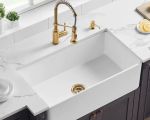- 1-Preparation-and-tools-needed
- 2-Removing-the-old-range-hood
- 3-Installing-the-new-range-hood
- 4-Finalizing-installation-and-testing
1. Preparation and Tools Needed Before Installing a New Range Hood
Installing a new range hood in the kitchen can seem daunting at first, but with the right preparation, it becomes a manageable and rewarding DIY project. The key to a smooth installation is gathering all necessary tools and understanding your kitchen’s ventilation layout.
Essential tools typically include a drill, screwdriver, measuring tape, level, wire strippers, and possibly a stud finder. Before you begin, measure the space where the new range hood will be installed, ensuring the size matches your stove or cooktop width for optimal ventilation performance.
Equally important is checking the type of ventilation your kitchen uses: ducted or ductless. Ducted systems expel air outside, requiring a vent pipe, while ductless models recirculate air through filters. Knowing this helps you purchase the right range hood and plan the installation accordingly.
From my personal experience helping a friend upgrade their kitchen, planning the electrical connection early made the entire process smoother, preventing unexpected delays.
2. Removing the Old Range Hood Safely and Efficiently
2.1 Disconnecting Electrical Power
Before removing your existing range hood, safety should be your top priority. Turn off power to the range hood circuit at your home’s breaker panel. This eliminates any risk of electric shock while handling wiring.
2.2 Detaching the Old Hood
Next, carefully detach the old hood from the wall or cabinet. This often involves unscrewing mounting brackets and disconnecting the ductwork or filters. In some cases, you may need to patch minor wall damage or repaint after removal.
During this phase, take note of the wiring setup and duct placement. Photographs can be very helpful to reference when installing your new hood.
3. Installing the New Range Hood Step by Step
3.1 Mounting Brackets and Positioning
Start by securely mounting the new brackets according to the manufacturer’s instructions. Use a level to ensure the hood sits evenly, which is crucial for both aesthetics and function.
3.2 Electrical Wiring Connections
Connect the electrical wires from your kitchen power supply to the new range hood. Typically, this involves matching wires by color—black to black, white to white, and grounding wires to the green or bare copper wire. If you’re unfamiliar with electrical work, consulting a professional can avoid hazards and ensure code compliance.
3.3 Attaching the Vent Duct or Installing Filters
If your range hood is ducted, carefully connect the vent duct to the hood outlet and secure it with clamps or duct tape designed for HVAC use. For ductless models, insert the carbon or charcoal filters as per instructions to enable effective air recirculation.
A memorable case involved a homeowner who installed a ductless range hood but initially forgot to place the filters, resulting in poor air quality until the issue was corrected.
4. Finalizing Installation and Testing Performance
4.1 Securing the Hood and Cleaning Up
Once the hood is mounted and connected, double-check all screws and fixtures for stability. Clean up any debris or dust created during installation to leave your kitchen spotless.
4.2 Testing the Range Hood Functionality
Restore power and test the new range hood by turning it on at different speed settings. Listen for unusual noises and confirm the airflow is adequate. For ducted systems, you can verify venting outside; for ductless, ensure filters are properly filtering odors and smoke.
Regular maintenance such as cleaning or replacing filters will extend the life and efficiency of your range hood.
Installing a new range hood in your kitchen not only improves air quality but can enhance your cooking experience significantly. If you want to explore high-quality range hoods or professional installation services, Improvement offers reliable products and expert support tailored to your needs.








